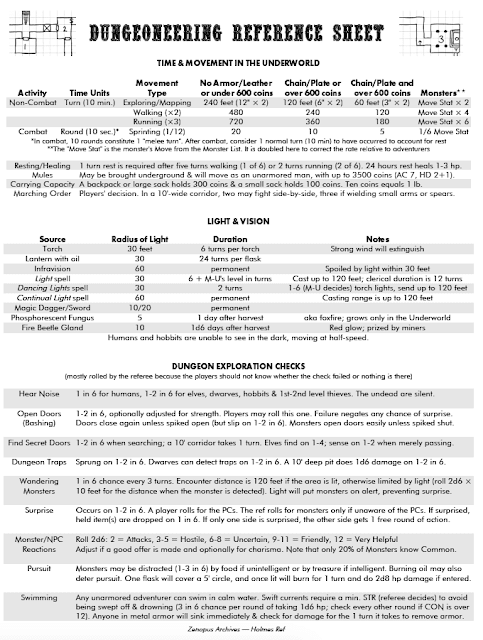 |
Screenshot (click on image for a larger view) |
Another week, another Holmes Ref sheet!
This one is a true DM's aid for dungeon exploration using the Holmes ruleset, covering Time, Movement, Light, Surprise, Wandering Monsters, Reaction Rolls etc.
DUNGEONEERING REFERENCE SHEET (click here to download)
A few notes:
---The 1/12 movement rate for combat rounds comes from two sources:
(a) the rates given by Holmes in the section "Combat Rounds, Time and Movement in Melee" on page 20, where indicates that movement in melee "is usually at a sprint; an unarmored man can move 20 feet per melee round, a fully armored man only 10 feet".
(b) the extension of the above rules on page 3 of the first printing of B2 Keep on the Borderlands, which repeats the above rates, plus give 5 feet per round for Armored & Encumbered, and states that a monster's melee move can be determined by dividing the monster's move by 12 (although this really should be 6, see below).---Monster Movement. The column for "Monsters" on the Time & Movement table doubles the movement rate for monsters. This corrects a problem I noticed a number of years ago regarding the relative movement rates of characters as compared to monsters, as explained in this thread on ODD74.
To reiterate: OD&D had movement rates of 12" (120' in the dungeon) for light foot, 6" (60') for heavy foot, and 3" (30') for encumbered heavy foot. These are given in the Encumbrance Table on page 15 of OD&D Vol 1.
But OD&D Vol 3 further explains that characters get two moves in a 10 minute turn, and thus gives a movement rate of 120' for a fully armored character (which is equivalent to heavy foot). Thus, the 60' rate for heavy foot (fully armored) is actually 120' in the dungeon.
Holmes, when making the Movement table for Basic, incorporated this double move into the listed rates, and thus giving an Exploring rate of 240' feet for unarmored (i.e. light foot), 120' for metal armor or encumbered (i.e., heavy foot) and 60' for metal armor & encumbered (i.e., encumbered heavy foot).
However, the Movement table in Holmes does not include monsters, and the Monster List in Holmes does not incorporate this same double move per turn, and instead simply gives a Move stat for each monster that is as exactly given in the list in OD&D Vol 2.
Without giving monsters these two moves, characters are going to be moving twice as fast relative to monsters. You can see this if you scan a list of monster movements (for example, in my Monster Reference Table), and note that the 240 feet/turn Exploration rate for an Unarmored men given in the Movement table is faster than any monster Move stat on the list other than Horses and some flying beasts. If you further compare the 240 feet/turn Exploration to the humans in the monster lists in Holmes, which including Bandits and Berserkers (each in leather armor), you will see that they have a move of 120 feet/turn, half of that of characters.
So to correct this, I've included a Monsters column, where it is noted that the movement for a monster in a turn should be double their Move stat from the Monster List. This doubling applies to ally of the movement rates: Exploring, Walking Normally, Running and Combat.
---The Phosphorescent Fungus is from the Sample Dungeon, Room L. Holmes also used this in the Maze of Peril. Real world fungal bioluminescene is known as foxfire. As I've written previously, "Margaret St Clair's The Shadow People, an Appendix N book that I read and enjoyed, has an extensive worldwide underworld lit by foxfire, but I don't know whether Holmes was familiar with this book."
---The Swimming rules are from the Sample Dungeon, Rooms H and M.
As usual, please let me know if you spot any typos & ask questions about anything unclear.
Long, long, long ago, we used to play with the fungus in our games. I don't know why it got dropped. I ought to re-install it.
ReplyDeleteWhen finding it, we used to say, "The fungus is among us."
This is great, and should totally be included in the ref sheets pdf :D
ReplyDelete